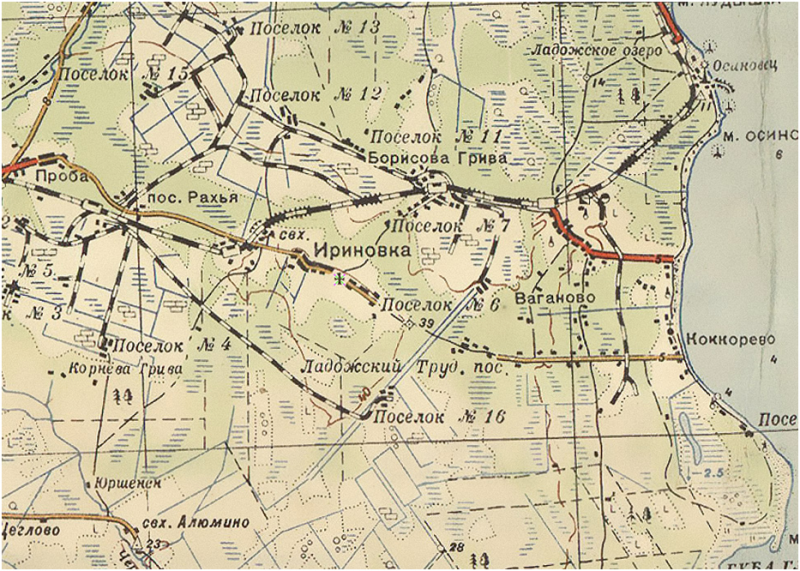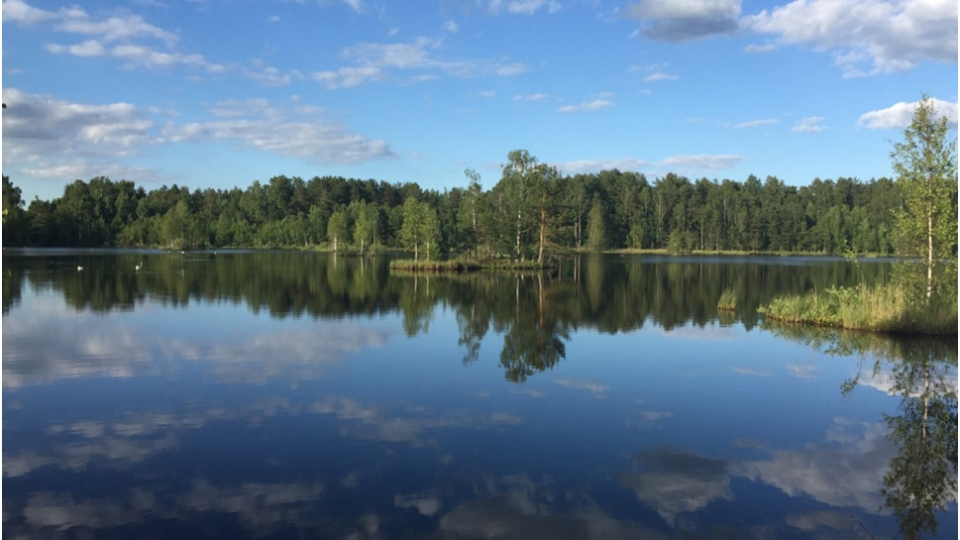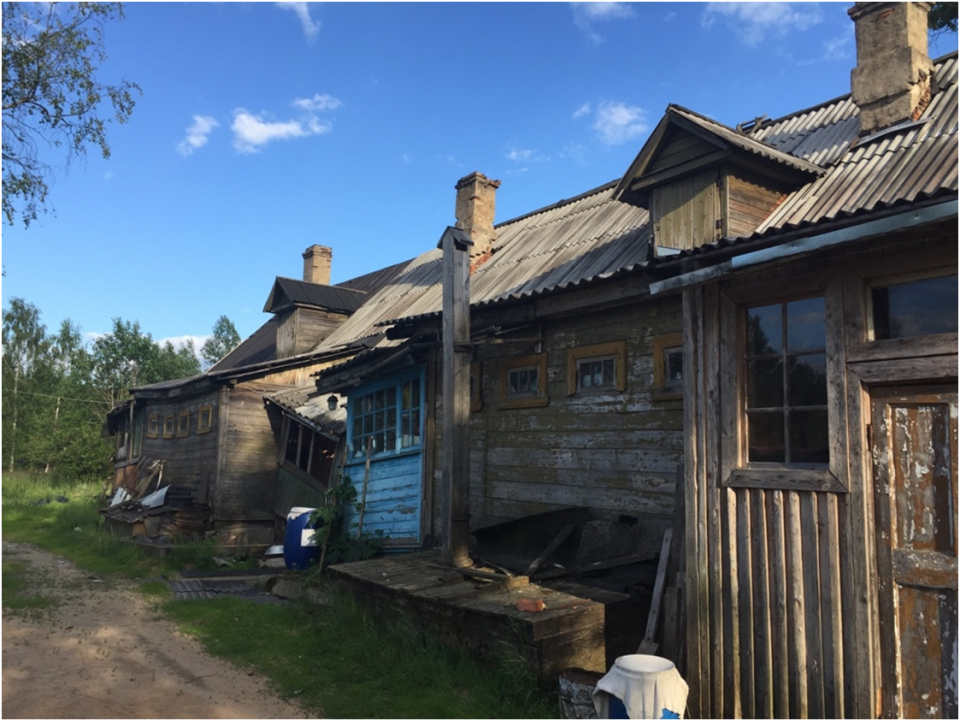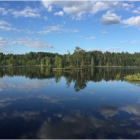This picture of a body of water tends to elicit positive emotions, at least in my experience. Clouds and trees mirrored on the water’s surface, glimpses of waterfowl, and a forest greening in the background usually make family, friends, and students agree that this is a beautiful spot, peaceful and calm—natural. When I mention that the image shows an abandoned peat extraction site in the Russian Northwest, a 45-minute drive from the city of Saint Petersburg, the photograph often turns into a proof of nature’s ability to recover from human assaults. Nature, I am told, will always come back, for humans are not more than a footnote in the history of the earth (Figure 1).
Yet, the meanings of landscapes are contested, and so are ideas of how humans and the non-human environment relate to each other and how this relationship should look. Less than half an hour after I took this picture, I spoke to a resident of the nearby Workers’ Settlement no. 13. Born in 1930, the woman moved there from a rural district in the region of Belgorod near the Ukrainian border in the 1950s. Employment in the peat company Irinovka gave her a stable income and living standard well above what she had been used to from her life on a Soviet collective farm. The woman is one of the few people who have stayed after excavations came to an end in the late Soviet period. Surrounded by empty houses and abandoned garden plots, the former peat worker relies on a subsistence economy. I assume she gets some support from her neighbors who work for a security company in the city. For her, this is a landscape not of recovery, but of loss and decline (Figure 2).
The environs of Saint Petersburg remind us of a largely forgotten chapter in Russia’s transition from the solar to the fossil fuel age. Commercial peat extraction around the old village of Irinovka started in the late nineteenth century, when peatlands in the European part of Russia turned into hinterlands of industrial areas with their ever-increasing appetite for energy. After the 1917 Revolution, the Soviet government promoted the use of peat to fuel electric power plants spurred by Lenin’s enthusiastic support for the development of local fuel. Later during the Soviet period, peat was increasingly distributed as a fertilizer to surrounding farms. The peat industry fundamentally transformed the region. Drainage canals diverted waters from the excavation sites into collecting ponds or into Lake Ladoga just a few kilometers away; new settlements were founded to house the company’s workers, and a network of narrow-gauge railways served to transport peat and people (Figure 3).
Social and environmental change can hardly be separated from each other in the region. Soviet peat companies reconfigured peatlands as social spaces, providing infrastructure, welfare services, and leisure time facilities for their employees. Workers’ Settlement no. 13, the woman remembers, was once “packed with people.” As was the case for most settlements, it had a dance hall, a medical station, a shop, a school, and a kindergarten. Nowadays, she lives amidst the remnants of a different time, increasingly vulnerable, as coordinated efforts to control the environment have ceased. Water and trees are encroaching on the settlement, and during the winter, wolves have attacked her chicken. The woman is also anxious to keep her cat inside the house at nighttime. Being intimately connected with her chicken and the cat, she is troubled by the lack of control over the boundaries between herself and a part of nature that threatens her livelihood.

Figure 3. Map of the Red Army, 1942, showing wetlands, drainage canals, settlements, and narrow-gauge railway lines of the Irinovka peat company.
Figure 3. Map of the Red Army, 1942, showing wetlands, drainage canals, settlements, and narrow-gauge railway lines of the Irinovka peat company.
Map by the Red Army, 1942.
Courtesy of the Ministry of Defense of the Russian Federation. Click here to view source.
 This work is licensed under a Creative Commons Public Domain Mark 1.0 License.
This work is licensed under a Creative Commons Public Domain Mark 1.0 License.
Landscapes have multiple layers and they are always in flux. For many decades, peat extraction shaped humans’ relationship with the nonhuman world in the region of Saint Petersburg. Without a guide, it will soon be hard to access some of the places in which people lived and worked in the not-too-distant past. At the same time, new layers of human-nature interactions constantly overlap with and incorporate this past into the present: a landfill on drained wetlands; abandoned peat pits that turned into fishing ponds; roads following the routes of the railways after the tracks were disassembled. While peat mining has ceased some decades ago, it keeps impacting how people interact with their local environment until the present day.
The legacy of peat extraction goes beyond such changes on the surface of the earth. When I visited the place in the summer of 2018, Greenpeace Russia reported that around 30 hectares of abandoned peatlands had caught fire, just 50 kilometers away from Workers’ Settlement no. 13. Posing serious threats to local environments and human settlements, such fires are a regular occurrence on abandoned peat extraction sites to which no water has returned. In the hot and dry summer of 2010, wildfires in a former peat-mining region affected large areas southeast of Moscow, revealing the vulnerability of degraded wetlands in the context of global warming. Moreover, as peatlands are crucial carbon stores and sinks, the ecological ramifications of drainage and the burning of peat transcend the local level. In fact, peat extraction in Irinovka was one of the countless episodes in the history of anthropogenic climate change. If humans are a footnote in the history of the earth, then this footnote is a very long one. We had better study it carefully.
How to cite
Bruisch, Katja. “Layers of Meaning and Layers of Time in a Former Russian Peat Mining Region.” Environment & Society Portal, Arcadia (Autumn 2019), no. 36. Rachel Carson Center for Environment and Society. doi:10.5282/rcc/8796.
ISSN 2199-3408
Environment & Society Portal, Arcadia
 This work is licensed under a Creative Commons Attribution 4.0 International License.
This work is licensed under a Creative Commons Attribution 4.0 International License.
2019 Katja Bruisch
This refers only to the text and does not include any image rights.
Please click on an image to view its individual rights status.
- Bruisch, Katja. “Nature Mistaken: Resource-Making, Emotions and the Transformation of Peatlands in the Russian Empire and the Soviet Union.” Environment and History (2018).
- Coopersmith, Jonathan. The Electrification of Russia, 1880–1926. Ithaca, NY: Cornell University Press, 1991.
- Josephson, Paul, Nicolai Dronin, Ruben Mnatsakanian, Aleh Cherp, Dmitry Efremenko, and Vladislav Larin. Environmental History of Russia. Cambridge: Cambridge University Press, 2013.
- Kopenkina, Liubov V. Istoriia torfianogo dela v Rossii. Tver’: Triada, 2015.










